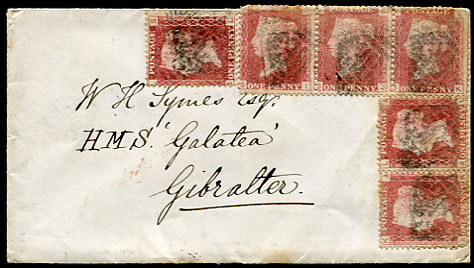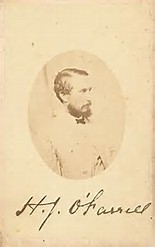

| HRH Prince Alfred round-world-voyage ended by Fenian assassination bullet, Gibraltar postal history
1867 cover from Tinahely to W.H. Symes, HMS 'Galatea', Gibralter (sic) with pair GB QV 1d red Plate 84 and strip of three, single Plate 85 pmk'd Rathdrum "388" diamond numerals when Ireland was a part of Great Britain, Tinahely and Rathdrum backstamps for MR 16 67 with London MR 18 67 transit. Prince Alfred, Duke of Edinburgh, Queen Victoria's second son (1844-1900) was never expected to be King and joined the Royal Navy as a midshipman aged 12. In 1867 he commissioned and commanded the 'Galatea' for a voyage around the world which would include the first royal visit to Australia. On FE 26 1867 the 'Galatea' left Plymouth Sound for the Mediterranean with stops at Lisbon, Gibraltar (MR 14 to 26), Malta, a stay at Marseilles prior a crossing to Rio de Janeiro, returning via Tristan Da Cunha, staying at Cape of Good Hope prior onwards to Adelaide, South Australia with subsequent stays at Melbourne, Victoria and Tasmania. The tour was abruptly curtailed in Sydney NSW on MR 12 1868 when Henry James O'Farrell, a Fenian sympathiser, attempted to assassinate the Prince - the Duke fell forwards on his hands and knees exclaiming "Good God! I am shot; my back is broken". On board was surgeon James Young, M.D. and Assistant Surgeons William L. Powell and William H. Symes (1851-1933 of Tinahely), the two former names being mentioned as giving immediate assistance to His Royal Highness who was tended back to health by six recently arrived nurses trained by Florence Nightingale.
Full details of the voyage can be found in the 487 page book entitled "The Cruise of H.M.S. Galatea" by John Milner and Oswald Walters Brierly. Prince Alfred was the first serious stamp collector in the royal family. He sold his collection to King Edward VII who shared his enthusiasm, who in turn gave it to his son King George V. Keenly expanded by the latter the two collections became the basis of what is now the Royal Philatelic Collection.
£1250 | |